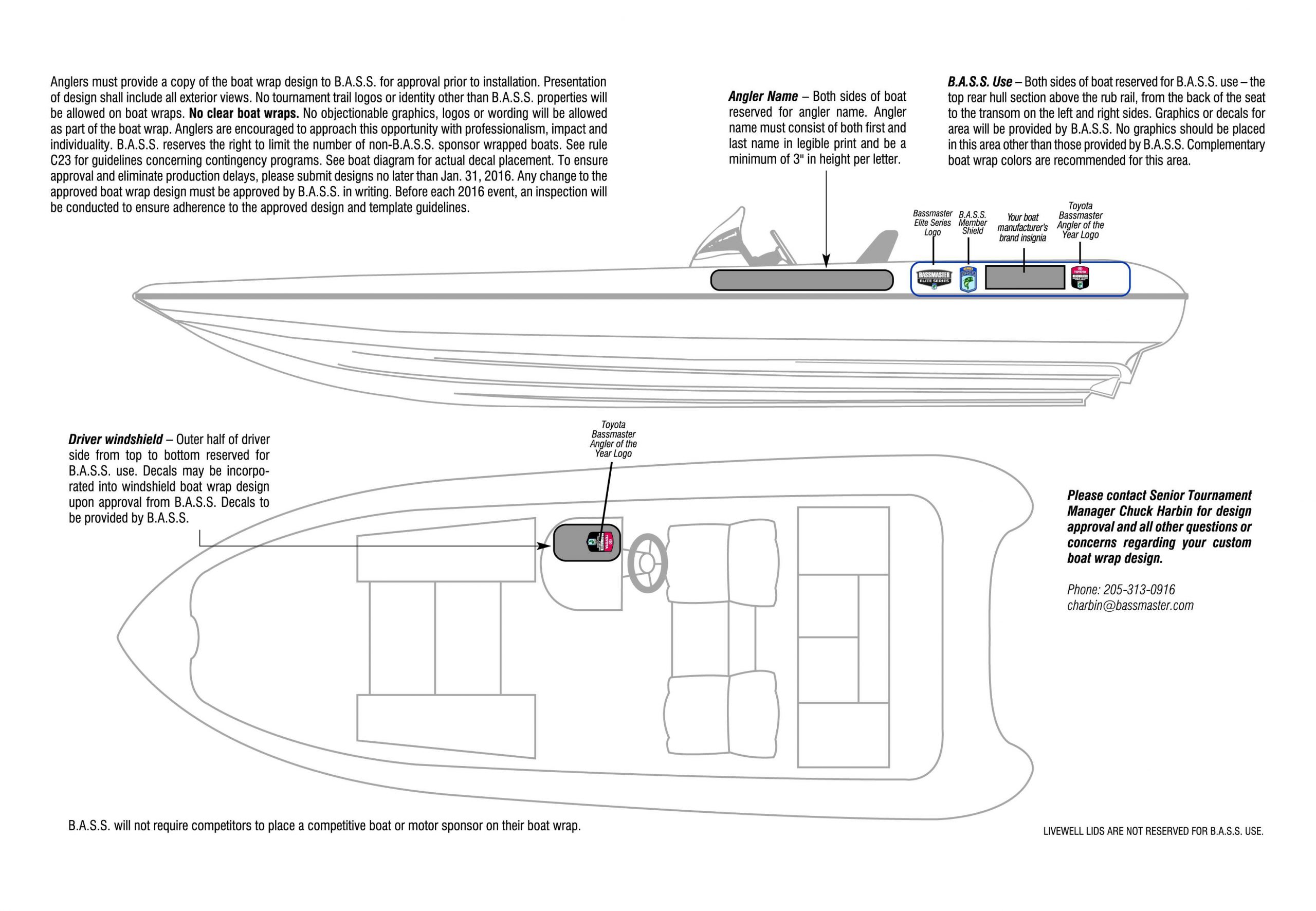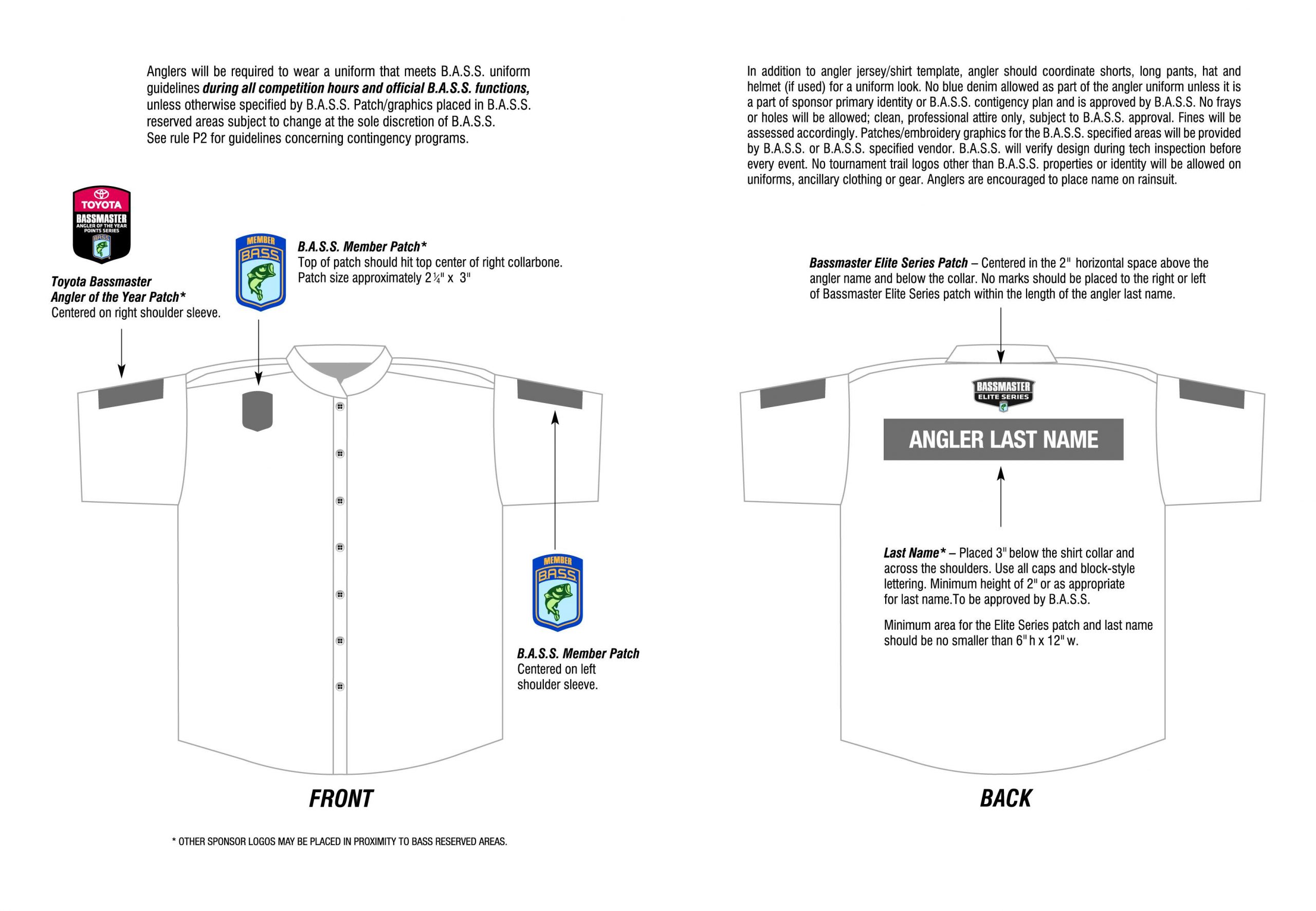
At the beginning of each Bassmaster Elite Series season, those anglers who qualified to participate receive an invitation. Upon accepting that invitation, they begin the process of conforming to the rules and guidelines set forth by the tournament department. Part of that includes the submission of any graphics to be applied to our tournament boats and apparel.
Much like NASCAR, the Elite Series rulebook includes “templates” that tell us where certain logos must be positioned and at what size – both on our boats and jerseys. The guidelines aren’t all that strict, but they are enforced. The idea is to provide signage for B.A.S.S. while maintaining some uniformity among the anglers.
For boats, we’re required to place a series of small decals above the rub-rail, on both sides toward the stern. These include the Toyota Bassmaster Angler of the Year, Elite Series and B.A.S.S. logos. The AOY logo must also appear on the driver’s side windshield.

Also above the rub rail, at mid-ship, is the space designated for the angler’s name. Beyond that, the rest is a canvas to which we can apply our own design and sponsor logos. And that is where a graphic artist comes in.
All dressed up
Some anglers rely on sponsors to develop their designs — usually a “title” sponsor. In doing so, that company typically dominates the space. Others use graphic artists, many of whom work in-house with the sign companies who print and install our wraps.
Like many Elite Series pros, my tournament apparel matches the design used to wrap my boat and tow vehicle. It’s sort of a branding effort to establish our own look. Jerseys, too, have design restrictions. The B.A.S.S. and Elite Series logos go in designated locations. Beyond that, it’s pretty much up to us and our sponsors to work out the size and placement of each logo.

However the overall design is created, it involves a process of back and forth dialog that can take considerable time. When a design is finally agreed upon, it’s then presented to the tournament department for approval.
Rejections are rare, but they happen. Usually, as long as the logos mandated by B.A.S.S. are in their specified spots and there’s nothing offensive or distasteful about the design, it’s a quick sign-off and we’re good to go.
The apparel process takes approximately three to four weeks. Boats and vehicles only require two to three days – depending on the company who’s doing the wrap and how busy they are. And believe me, at this time of year, they can be very busy!
I get my boat and tow vehicle wrapped by WrapThisInk, a sign company located in Orlando, Fla. They’re the same guys who do wraps for B.A.S.S. and a bunch of major fishing brands. Their client list includes many of the top pros on tour, including Kevin Van Dam, Shaw Grigsby, Gerald Swindle, Casey Ashley and Mike Iaconelli. In fact, it’s safe to say most of the boats you’ll see traveling through the tunnel at the GEICO Bassmasters Classic in Tulsa will have been wrapped by them.
Nuts and bolts
To begin the wrap process, all surfaces must be thoroughly washed and any external parts or trim pieces removed. That goes for boats and tow vehicles as well.
For vehicles, the mirrors, door handles, emblems, etc., are removed in order to provide a smooth, unobstructed surface. On a boat, it’s the cleats, rub rail, trolling motor and any other external accessories. Once those are out of the way, the surface is then given an alcohol bath – to remove dust and any impurities. It’s sort of like applying a fresh coat of paint … if you want it to stick, the surface needs to be properly prepped.
While this is going on, the graphic artist is feeding the design, via computer, to a large printer. The printer then transfers the design onto a large roll of adhesive 3M film. When printing is complete, the film is laminated to a clear material for added durability, then cured for 24 hours. After that, it goes to the techs who do the installation.
Once the wrap is applied, then the rub rail, trolling motor and other accessories can be reinstalled. Next, they add what’s referred to as “second surface” signage, which simply means smaller decals over the original surface. Then the finished product is ready for photographs.
From the time we sign the Elite Series Participation Agreement, to when the wrap and jerseys are finished, we’re talking about three to four weeks. It’s a long, tedious process, but one that’s required in order to compete.
For a sneak preview of some of the boats that will debut at this year’s Bassmaster Classic in Tulsa, check out this photo gallery.

